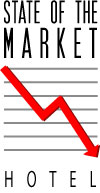
Surveys
DJC.COM
December 10, 2009
Is the recession for hotels ready to end?
PKF Capital

Burdett
|
Are we there yet?
Remember the days when this question referred only to the seasonal trip to the in-laws or the start of the mandatory summer vacation road trip? Today it is primarily in reference to the end of the recession.
Are we there yet? By all accounts, nobody really knows and given the long-term time horizons of hotel development and ownership, it really shouldn’t matter. What matters is the direction our industry is headed, recession or not. Unfortunately, the consensus seems to think we are heading into a year that by all measures will be worse than 2009.
Is that possible?

There are a number of economists with more data and better analysis predicting what will happen next, but in the hotel industry the fervor and exuberance of the next deal and projections of unstoppable growth must be replaced by traditional fundamentals. This industry has proven its resiliency through every cycle. The shift back to core operating values, actual sales and marketing efforts, stabilized rate and occupancy growth, and pure competitiveness will lead the hospitality industry out of this recession as it has during the past five recessions since 1980.
The statistical approach
Let’s look at some simple statistics that impact hotel lodging, not just in the Northwest, but around the country.
Employment (or lack thereof) is a principle indicator when it comes to hotel occupancy and average daily room rate, or ADR. People without jobs tend to have little discretionary income and do not travel. Nationally, unemployment is at a level not seen since the summer of 1983, approximately 10.2 percent by last measure. Washington is not far behind at 9.3 percent and both are predicted to rise through the middle of 2010.
Supply and demand are, and always will be, leading indicators for hotels. Since every hotel is a speculative development and the idea is to rent rooms every night as opposed to long-term leases, hotels fundamentally have a greater immediate impact from new supply than other comparable commercial real estate investments such as office, industrial or multifamily.
Demand, on the other hand, is created by a number of sources. Employment tends to be one of the critical elements, however corporate and consumer spending, incentive travel, GDP growth and even housing trends impact hotel and travel demand. In the Northwest these impacts are evident in the following statistics:
Greater Seattle

Photo courtesy of PKF Capital
The beautifully maintained Hotel Vintage Park in Seattle set the high-water market for cost per room when it was sold in September of 2007. |
• Our preliminary forecast for Seattle-area hotel RevPAR (revenue per available room, which is occupancy times ADR) is for a decrease of 18.5 percent for year-end 2009, following a 1.5 percent decrease in 2008.
• We estimate a sharp decline in occupancy of approximately 8 percent, ending 2009 at 62.8 percent, a level achieved only once in the last decade (post Sept. 11 attacks).
• Looking towards 2010, Seattle is estimated to reverse a two-year RevPAR decline by showing a slight 0.3 percent growth.
Greater Portland
• Our preliminary forecast for Portland-area hotel RevPAR is for a decrease of 19.3 percent for year-end 2009, following an increase of 2.9 percent in 2008.
• We estimate a sharp decline in occupancy of approximately 11.3 percent, ending 2009 at 58.4 percent, slightly above the estimated national occupancy forecast of 54.9 percent.
• Unfortunately for Portland, we estimate a continued RevPAR decline for 2010 of 1.4 percent, capping a two-year decline of more than 20 percent from a 2008 peak.
Financial impact
Let’s start with the good news. Interest rates will remain low for the foreseeable future. One year LIBOR, currently at 1.19 percent, continues to be at its lowest point in more than a decade. The 10-year treasury remains at historical lows of 3.36 percent (November). This is in comparison to prior severe recessions that occurred in 1989 at 9.32 percent (February) and 1982 at 14.4 percent (June).
The Federal Reserve recently indicated it will keep interest rates low for the next few years. The current credit crunch and lack of lending throughout the U.S. continue to aid the Northwest, keeping hotel development at or near its lowest levels in more than a decade. New hotel supply growth (year-over-year) nationally is predicted to drop to 1.2 percent in 2010, with less than .03 percent growth through 2012, compared to an increase in hotel supply of more than 5.6 percent during the last 24 months.
However, the bad news tends to overshadow the good. The financial impact of such significant drops in occupancy and ADR and the estimated 2009 national RevPAR decrease of 18 percent have no doubt taken a toll on operators, but an even greater impact has occurred for hotel owners.
Decreases in travel and loss of room nights have significantly impacted overall net operating income (NOI) throughout our industry. Even with significant cost containment in 2009, the average U.S. hotel is forecasted to suffer a 37.8 percent decline in NOI from 2008 to 2009, the largest drop since PKF started keeping records in 1938. Combine this with an increase in capitalization rates for hotel investments in the 400-500 basis point range and our industry experiences paper losses in real estate value in the billions of dollars.
Pick up any periodical or newspaper and there is an unprecedented amount of distress in all real estate classes, including hotels, casinos and resort developments. Owners are being crushed by debt loads secured when loans were being made on the belief that cash flow would increase in perpetuity and values would grow exponentially.
The primary difference with this recession is that it was not caused by an increase in supply or a onetime anomaly, but an over abundance of money and the resulting craze, similar to the housing market, where hundreds of billions of dollars in unsecured commercial mortgage-backed securities loans, collateralized debt obligations, life-company and bank loans were made.
Money flowed as if the party would never end, clearly at an unsustainable rate. Even worse, the originators sliced and diced the capital stack to a point where many investors (including hedge funds, equity funds, real estate investment trusts and some small nations) didn’t even know what tranche they were buying and the result has been catastrophic.
The silver lining
Like all good stories, there tends to be a happy ending. The hotel industry will reset and remember the ground rules and fundamentals, not only in operations but in development and lending practices as well. Owners who have strong balance sheets and the financial capability to weather the storm will actually come out stronger, with less competition, leaner and with greater demand. Smart lenders, and owners, will face the facts, understand the time horizon and deal with problem assets head on.
Like all recessions this too will end and, once again, the cycle will begin its upward swing. It is hard to predict in these uncertain times if the end is near or exactly where the inflection point may be, but given all the data and the resiliency of the hotel industry (both as an investment and in operations), we do expect to see the light at the end of the tunnel arrive late in 2011.
Chris Burdett is the senior managing director at PKF Capital in Seattle. His office has handled more than $500 million in hotel sales around the Northwest in the last five years.
Other Stories:
- ‘Game changers’ show what’s ahead for commercial real estate
- Need a loan? Here’s what you should know
- Are you prepared for the big flood?
- Aigner finds calm after near-death experience
- 10 things I learned in Green Broker school
- A lean, mean, clean and green future
- Pioneer Square gets ready for change
- New office towers help CBD move north
- Sumner’s industrial market weathers the economic storm
- Retail’s bumpy ride starts to smooth out
- Further pain coming in the multifamily markets
- Bellevue’s office market more ‘fit’ than Seattle’s
- Relax; it’s only a business cycle
- Dean C. Allen
- William Pollard
- Chris Pratley
- Why the economic loss rule matters
Copyright ©2009 Seattle Daily Journal and DJC.COM.
Comments? Questions? Contact us.